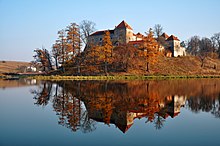Swirsch
| Swirsch | ||
| Свірж | ||

|
|
|
| Basic data | ||
|---|---|---|
| Oblast : | Lviv Oblast | |
| Rajon : | Peremyshlyany district | |
| Height : | no information | |
| Area : | 2.82 km² | |
| Residents : | 795 (2001) | |
| Population density : | 282 inhabitants per km² | |
| Postcodes : | 81225 | |
| Area code : | +380 3263 | |
| Geographic location : | 49 ° 39 ' N , 24 ° 26' E | |
| KOATUU : | 4623386401 | |
| Administrative structure : | 7 villages | |
| Address: | 81225 с. Свірж | |
| Statistical information | ||
|
|
||
Swirsch ( Ukrainian and Russian Свірж ; Polish Świrz or Swirz ) is a village in the western Ukrainian Lviv Oblast with about 800 inhabitants.
Six other villages belong to the district council of the same name .
history
The place was first mentioned in 1416 as Szwyrzsz , and then later as Swerz (1443), Swyrz (1456), Swierz (1578) and so on. It initially belonged to the Lviv region in the Ruthenian Voivodeship of the aristocratic republic of Poland-Lithuania and to the Świrski family and was referred to as an oppidum (market town).
In 1484 Andrzej and Marcin Świrski established a Roman Catholic parish. In 1581 the new brick church was built. The castle was built in the 16th century. The aristocratic Cetner family ruled the village since the middle of the 16th century.
During the first partition of Poland in 1772 the village became part of the new Kingdom of Galicia and Lodomeria of the Habsburg Empire (from 1804). In the 19th century the village had many owners: Sierakowski, Straczewski, Pierzchała, Wiktor, Iliasiewicz, Czaykowski, Tustanowski and Krzeczunowicz. In the early 20th century the village of Irena (Wolański) Pinińska, whose second husband was Mr. Robert Lamezan de Salins , a general in the Austrian and Polish armies. The last noble owner was the general's daughter, Irena, and her husband, Mr. Tadeusz Komorowski .
In 1900 Świrz had 389 houses with 2346 inhabitants, of which 1913 were Polish-speaking, 421 Ruthenian-speaking, 1575 Roman Catholic, 418 Greek Catholic, 352 Jews, 1 of other faiths.
After the end of the Polish-Ukrainian War in 1919, the community became part of Poland. In 1921 miasteczko (small town) Świrz had 405 houses with 2293 inhabitants, including 2174 Poles, 109 Ruthenians, 7 Jews (nationality), 3 other nationalities, 1894 Roman Catholic, 215 Greek Catholic, 184 Jews (religion).
In the Second World War , the place belonged first to the Soviet Union and from 1941 to the General Government , from 1945 back to the Soviet Union, now part of the Ukraine . In 1944, 14 Poles were killed by OUN-UPA. On July 18, 1944, in Aktion Burza, a German fleet of vehicles was attacked by the Polish Home Army and 40 people were killed in escort.
Attractions
- Castle from the 16th century (completely destroyed in 1914, later rebuilt)
- Former Catholic Church (built 1546)
- Greek Catholic Church (19th / 20th century)
Sons and daughters
- Andrzej Żaki (* 1923), Polish archaeologist
- Alicja Grześkowiak (* 1941), Polish national conservative politician and lawyer
- Anychka (* 1977), Ukrainian singer
Web links
- Świrz . In: Filip Sulimierski, Władysław Walewski (eds.): Słownik geograficzny Królestwa Polskiego i innych krajów słowiańskich . tape 11 : Sochaczew – Szlubowska Wola . Walewskiego, Warsaw 1890, p. 717 (Polish, edu.pl ).
Individual evidence
- ^ Anna Czapla: Nazwy miejscowości historycznej ziemi lwowskiej [The names of the localities of the historical Lviv country] . Towarzystwo Naukowe Katolickiego Uniwersytetu Lubelskiego Jana Pawła II, Lublin 2011, ISBN 978-83-7306-542-0 , p. 97-98 (Polish).
- ↑ a b c Grzegorz Rąkowski: Przewodnik po Ukrainie Zachodniej. Część III. Ziemia Lwowska . Oficyna Wydawnicza "Rewasz", Pruszków 2007, ISBN 978-83-8918866-3 , p. 358-362 (Polish).
- ↑ Ludwig Patryn (Ed.): Community encyclopedia of the kingdoms and countries represented in the Reichsrat, edited on the basis of the results of the census of December 31, 1900, XII. Galicia . Vienna 1907.
- ↑ Główny Urząd Statystyczny: Skorowidz miejscowości Rzeczypospolitej Polskiej. Województwo tarnopolskie . Warszawa 1928 (Polish, online [PDF]).
- ↑ Anychka (English) (Ukrainian)






